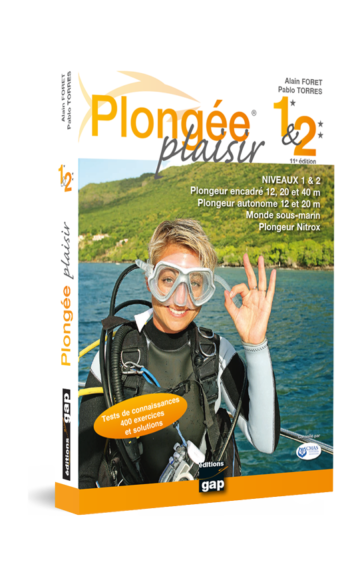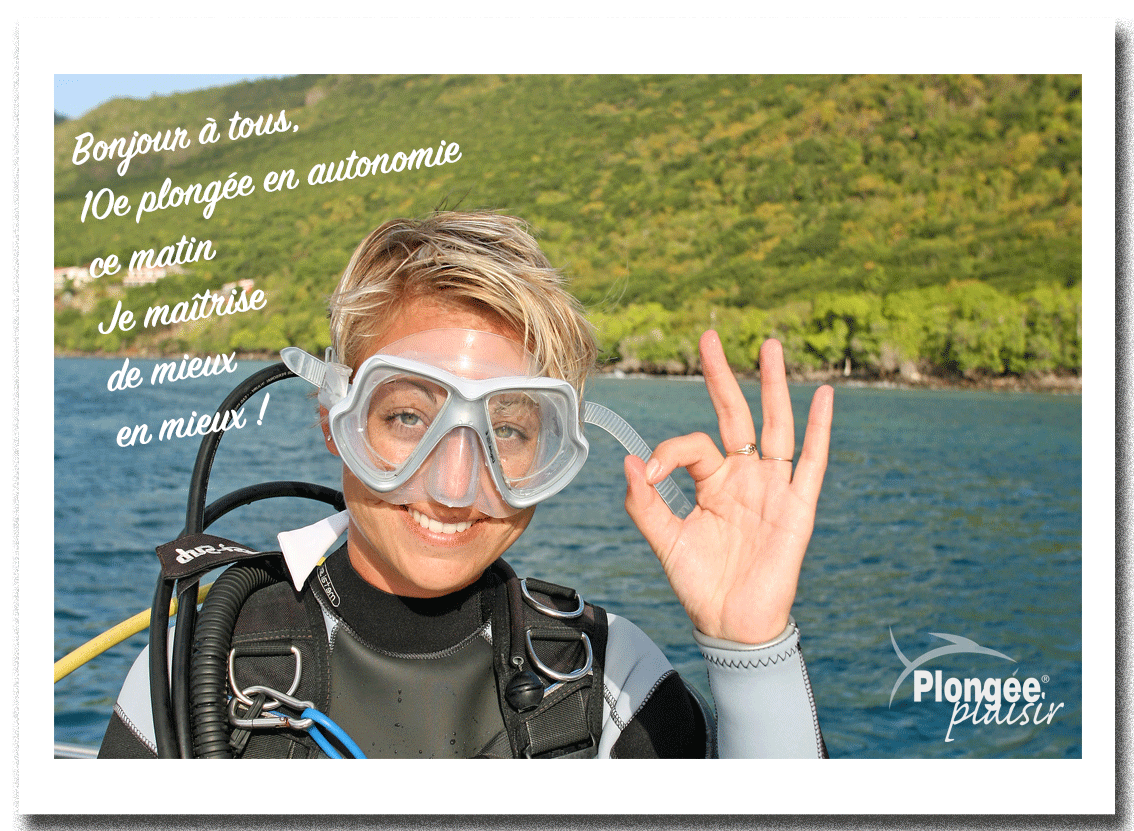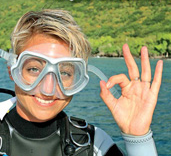
- Publisher: 384 p.
- Editor: GAP editions
- Editing: 12e édition, 2024
- Available in: Paper
- ISBN: 9782741707561
N ° 1 FOR DIVING TRAINING BOOKS![]()
12e édition janvier 2024

Pleasure 1 & 2 diving, training book for diving certificates levels 1 & 2 and associated skills
Plongée Plaisir 1 & 2 combines Diving for Pleasure 1 and Diving for Pleasure 2, in the same volume, namely:
- the training content of Diving for Pleasure 1 ;
- the underwater world of Diving for Pleasure 2 ;
- the training content of Diving for Pleasure 2.
How to choose between Pleasure Dive 1, Pleasure Dive 2 and Pleasure Dive 1 & 2?
- "I only want to pass level 1 for the moment": Plongée Plaisir 1.
- "I want to pass level 2 or one of the associated skills but I have had insufficient courses at level 1 (or: I want to revise level 1)": Plongée Plaisir 1 & 2
- "I have mastered level 1 knowledge very well and I want to pass level 2 or one of the associated skills": Plongée Plaisir 2.
- "I already have Plongée Plaisir 1, I want to pass level 2 or one of the associated skills": Plongée Plaisir 2.
- “I have a doubt between Plongée Plaisir 2 and Plongée Plaisir 1 & 2 but I see that the price difference is small, I say to myself that I take Plongée Plaisir 1 & 2. "
Whether before or after lessons, you will find all the knowledge and technical skills to acquire, as well as numerous tests allowing you to self-assess at your own pace.
Skills or abilities covered:
- Diver levels 1 (Cmas P1 *) and 2 (Cmas P2 *)
- Supervised diver 20 m (PE-20) and 40 m (PE-40)
- Autonomous diver 12 m (PA-12) and 20 m (PA-20)
- Underwater world (environment, species identification and protection)
- Nitrox diver (PN)
Complies with the Sport Code and the program of the French Diving School (FFESSM, FSGT, ANMP, SNMP, UCPA) as well as the courses of the World Confederation of Underwater Activities (CMAS) and its member federations (French language: FLASSA-Luxembourg, FSSS-Suisse, CMAS.CH, LIFRAS-Belgium, CMAS Quebec,…).
Nouveautés de la 12e édition, 2024
In addition to the usual updates and the change of certain photographs, the novelties concern:
- Refonte de la partie “procédure de désaturation” du niveau 2 (fiche 56) afin d’intégrer, pas à pas plutôt que successivement, les procédures ordinateurs et les procédures tables ;
- Concernant les tables MN90, présentation d’une synthèse avec renvoi en annexes pour le mode d’emploi détaillé ;
- Pages d’explications simplifiées sur les facteurs de gradient (GF) et les ordinateurs de plongée (fiche 57) ;
- Ordinateurs de plongée et gestion des plongées successives ;
- Refonte de la prévention des risques d’ADD (fiche 55) ;
- Critères de choix des ordinateurs de plongée (rubrique matériel, Fiche 63) ;
- Actualisation de la partie sur la narcose (renforcement de la distinction entre les “signes” de narcose et la “crise” de narcose) ;
- Ajout d’une fiche sur l’Oedème pulmonaire d’immersion (OPI) ;
- Informations sur Ocean Academy (environnement, connaissance et protection du milieu) ;
- Simplification de la présentation sur les acteurs de la plongée ;
- Ajout de certaines questions/réponses dans les tests, en lien avec les modifications de contenu apportées.
In the press
One of the strengths of this “bible” is that it offers a large number of exercises (300) accompanied by their solutions […]
This new opus from the Plongée Plaisir collection, which has established itself for several years as a must-have in the world of palmipeds, has also been given a new presentation, offering more clarity and readability.
Diving MagazineA book full of information and photos. To dive without making a fuss.
The ExpressThanks to this book […], the reader discovers the techniques and the rules to be respected in order to be able to dive safely. The numerous photographs reinforce the educational approach.
The worldCrushing is no longer a chore.
International DiversAn effective and motivating educational approach.
Subaqua - Review of the FFESSM
They witness

Anne L.
The presentation of the different levels is clearly explained, the progression is easy.
The different chapters are pleasantly accompanied by explanatory images or photos and the focus on the essential points to remember is beneficial.
In short, it is a perfect book to start diving and thus assimilate more quickly the comments made by the instructor.Johnny from Colmar, May 2016.
Really very explicit book for beginners like me. Very well illustrated. The exercises with the very understandable answers. I recommend this book. And the icing on the cake: super reasonable price.Sarah G.
“Essential.
For all beginner divers !! Contains a wealth of valuable information to start this wonderful hobby.
Roll on level 3 for the next volume! “John
“Really a very good and well illustrated book to practice the practice of scuba diving.
I can't wait to experience the practice in real life in September “John, The Londe
Very good support to help pass the complete N2 diving book which takes over the N1 and allows to pass the N2 (in addition to the courses given by the club).E. Lyon
A perfect guide! This guide allowed me to review before passing my second level of diving after a year without practice. Clear and complete, I was able to get back into the bath before going back to diving ...
Summary
Foreword by Albert Falco
Thanks
Photographic credits
Introduction
Manual
Part 1 - Discover scuba diving
Level 1 • Supervised diver 12 m (PE-12) • Supervised diver 20 m (PE-20) Autonomous diver 12 m (PA-12)
Sheet n ° 1 How to start diving?
Prerogatives • Minor divers • Medical certificate • Insurance • Diving structures
Sheet n ° 2 First bubbles
Course of a baptism, also called "discovery dive"
Sheet n ° 3 The diver's equipment
General presentation of the diver's equipment
Sheet n ° 4 The fins
Which fins to choose? • Fitted or adjustable? • Put on your fins
Sheet n ° 5 The tuba
The different snorkels • The mouthpiece • The fixing system
Sheet n ° 6 The mask
Description • A face, a mask • Put on your mask
Sheet n ° 7 The diving suit
A combination, why? • The different types of combination • Cold and diving • Gloves
Sheet n ° 8 Rigging a diving suit
The diving bottle • Fixing the BC • Roles of the BC • Mounting the regulator • Connection of the direct-system • Opening of the bottle and pressure control • Rules and precautions to take with a scuba tank
Sheet n ° 9 Launching
Put your bottle in the water • Back tilt • Straight jump • Start from the beach
Sheet n ° 10 Buoyancy
Do you float? Me too ! • The combination: like a buoy • Bottle and weight belt • Ballasting • Benefit of correct ballasting • Check ballasting
Knowledge test n ° 1- 1
Sheet n ° 11 Getting around: kicking
Support (or vertical) kicking • Ventral kicking • Costal kicking • Dorsal kicking • “Respectful” kicking (4 rules: balance, horizontal, fins pointing slightly upwards, gentle kicking, with the “tips of the feet”)
Sheet n ° 12 Immerse yourself
"Expiratory casting" or "seal immersion" • Duck
Sheet n ° 13 Prevention of barotrauma
Pressure • Ears • Balancing methods • Sinuses • Teeth • Mask plating • Lungs
Knowledge test n ° 1-2
Sheet n ° 14 Breathe
Breathe with a snorkel • Breathe with a regulator • Remove and put your regulator back under water • Find your regulator • Check the amount of air available • Request and receive air • Avoid running out of breath • Notions of apnea
Sheet n ° 15 See
Mask and mist • New masks • Face water entering the mask (emptying the mask) • Mask and vision • Mask, glasses and contact lenses • Colors and depth
Sheet n ° 16 Balancing
Position in the water • Lung-ballast • Vest
Sheet n ° 17 How to behave in group
Definition of a team • Rules of conduct • Notion of pairs
Summary of essential concepts
Knowledge test n ° 1-3
Sheet n ° 18 Reassemble: the decompression phase
Never block your breathing • Go up slowly • The landings (computers and dive tables) • Pregnancy and diving • Boats (risks when approaching the surface, "overview")
Sheet n ° 19 Getting out of the water
Beach side dives • Go up on a tire • Go up on the ladder
Sheet n ° 20 Disequipping
Ungram your diving suit • Transport bags • Rinse the equipment • Disinfect the tips
Sheet n ° 21 Some precautions
Before diving • After diving (hydration, no effort, no plane, no apnea)
Knowledge test n ° 1-4
Final level 1 diver test
Sheet n ° 22 Self-diving qualification 12 m
Autonomy and responsibility • Essential equipment • Basic orientation • Mastering your autonomy in the air • Improving kicking and balance • Communication, safety and assistance • Using a landing parachute
Part 2 - The underwater world
Factsheet n ° 23 Oceans
Source of life and great regulators • Depth zones • Light and life • Temperature
Sheet n ° 24 Planet Water
Waves • Swell • Current • Salt • How do fish float? • Do the fish have blood? • Camouflage and protection • Are the fish drinking? • Plankton
Sheet n ° 25 The underwater environment
Rocky bottoms • Drop-offs • Sand • Open water • Giant algae (laminaria) • Coral reefs • Mangroves
Sheet n ° 26 Underwater life
Classification of species • Identification keys
Sheet n ° 27 The plant kingdom
Algae • Flowering plants
Sheet n ° 28 The animal kingdom: invertebrates
Sponges • Cnidarians: jellyfish, anemones, gorgonians, corals (hard, black, soft, Mediterranean red, fire coral) • Bryozoa: sea rose, Neptune lace, false coral • Worms: spirographs, sabelles, planarians, bonellies • Crustaceans: shrimps, lobsters, lobsters, crabs • Molluscs: gastropods (slugs, snails), bivalves (oysters, mussels, giant clams) • Cephalopods (octopus, cuttlefish, squid) Echinoderms: starfish, brittle stars, sea urchins, sea cucumbers • Ascidians ( tunicates)
Sheet n ° 29 The animal kingdom: vertebrates
Cartilaginous fish (rays, sharks) • Bony fish from temperate seas (castagnoles, wrasse, blenny, crenilabra, wrasse, mullet, red mullet, moray eel, conger, sea bream, oblades, sars, saupes, serrans, wolves (bass), corbs , mostelles, pout, capelin, pollack, grouper, scorpion fish, scorpionfish, sphyrenes (barracuda, bécunes) Bony fishes of coral reefs: parrotfish, triggerfish, napoleons, butterflyfish, coachfish, soldier fish, bigeyes, anthias, snappers, tropical groupers, angelfish, batfish, surgeonfish, stonefish, sweetlips, crocodilefish, pterois, pufferfish, boxfish Marine reptiles: snakes, marine iguanas, crocodiles marine, turtles Marine mammals: delphinids (killer whales, pilot whales, dolphins), beluga, narwhal, sperm whales, porpoises, whales, manatees, dugongs, sea lions, seals, walruses Ecosystems • Life with many
Sheet n ° 30 Approach to underwater species
Règle n°1 : ni bruit ni mouvement brusque • Règle n°2 : ne pas s’interposer entre le poisson et le courant
Règle n°3 : ne pas s’interposer entre la lumière et le poisson
Factsheet n ° 31 Protecting nature
Les causes • La vision de Jean-Michel Cousteau • La charte du plongeur responsable • Longitude 181 Nature • La charte du super plongeur ! • Ocean Academy
Test on the underwater world
Part 3 - Techniques improvement
Niveau 2 • Plongeur Autonome 20 m (PA-20) • Plongeur encadré 40 m (PE-40)
Presentation
UL 1 - Autonomous diving at 20 m
Fiche n°32 Une autonomie sous conditions
Autorisation du directeur de plongée • Plongeurs majeurs • Espaces d’évolution
Fiche de sécurité • Notions de palanquée et d’autonomie • Équipement individuel obligatoire • Fixation des instruments
Fiche n°33 Communiquer et assister un équipier
L’audition subaquatique • La vision subaquatique • Couleurs et profondeurs • Ecrire sous l’eau (ardoise) • Principaux signes de communication • Assister un plongeur
Fiche n°34 Lestage et immersion
Notions de flottabilité • Poids réel • Poids apparent • Poussée d’Archimède
Facteurs influençant la flottabilité
Fiche n°35 Consommation d’air et profondeur
La pression • L’air comprimé • L’autonomie en air diminue avec la profondeur
Calculs d’autonomie en fonction des réserves d’air et de la consommation du plongeur • Loi de Boyle-Mariotte • Facteurs influençant notre consommation d’air
Fiche n°36 Apprendre à s’orienter
L’orientation : des points de repère pertinents (soleil, côte, profondeur, courant, éléments caractéristiques, parcours en plongée) • S’orienter en l’absence de points de repère (déterminer un cap, suivre un cap sans dévier, évaluer une distance, changer de cap) • Choisir une boussole • Les boussoles électroniques (ordinateurs de plongée)
Fiche n°37 Utiliser un parachute de palier
Se signaler auprès de la personne assurant la sécurité de surface
Se signaler auprès des plaisanciers • Déployer un parachute sous l’eau
Test de connaissances n°2-1
UL 2 – Prévention des risques
Fiche n°38 Règles de bonne pratique
Règle n°1 : Un certificat médical annuel • Règle n°2 : Une reprise progressive
de la plongée • Règle n°3 : Repos et hygiène de vie • Règle n°4 : Exercice physique
Contre-indications
Fiche n°39 Prévention des barotraumatismes
Définition : traumatisme dû aux variations de pression sur les volumes fermés
Oreilles (le plus fréquent, souvent bénin) • Surpression pulmonaire (très grave, fort heureusement facile à éviter) • Sinus • Placage de masque • Dents Estomac et intestins
Fiche n°40 Pour ne pas vous essouffler
Risques associés à l’essoufflement : panne d’air, panique, noyade, surpression pulmonaire • Mécanisme • Conduite à tenir • Prévention
Fiche n°41 Froid et thermorégulation
Mécanisme • Conduite à tenir • Prévention
Fiche n°42 L’oedème pulmonaire d’immersion (OPI)
Mécanisme • Signes • Facteurs favorisants • Conduite à tenir • Prévention
Fiche n°43 Animaux marins et risques associés
Brûlures • Morsures • Piqûres
Fiche n°44 Le courant
Les plongées avec courant • Sens de l’exploration • Eviter l’essoufflement • Instruments de sécurité
Fiche n°45 Les vagues
À bord du bateau • En surface • En fin de plongée
Fiche n°46 Les eaux troubles
Evitez de perdre votre palanquée • Adaptez votre exploration
Fiche n°47 Les grottes et tunnels
Fiche n°48 Les épaves
Fiche n°49 Les plongées de nuit
Spécificités • Signes de nuit
Fiche n°50 Les filets ou cordages
Risques • Prévention • Instruments de sécurité : couteau, ciseaux, coupe-fil
Fiche n°51 Les embarcations
Risques (hélices) • Prévention
Fiche n°52 L’apnée ou plongée libre
Conseils d’amélioration des performances • Disciplines • Prévention des risques
Fiche n°53 L’assurance du plongeur
L’assurance en responsabilité civile (RC) • L’assurance individuelle accident
Contrats existants • Notions de responsabilité civile et pénale
Convention d’assistance • Assurance du matériel
Knowledge test n ° 2-2
UL 3 – La désaturation
Fiche n°54 Les risques de la désaturation
Mécanisme • Conséquences • Conduite à tenir • Foramen ovale perméable (FOP)
Fiche n°55 Prévention des risques d’accident de désaturation (ADD)
À l’origine : la formation de bulles • Respect du protocole • Prise en compte des facteurs individuels de risque • Éviter les profils à risque
Éviter les comportements à risque
Fiche n°56 Les procédures de désaturation (ordinateurs et tables)
La notion de palier • Paliers obligatoires • Paliers facultatifs • Paliers profonds
Ordinateur : avant de plonger • Procédures hétérogènes • Plongées simples (isolées ou unitaires) • Remontées lentes • Intervalle en surface entre deux plongées • Plongées successives • Non-respect des paliers facultatifs ou des paliers profonds • Procédures anormales ou dangereuses • Phase de constitution : réversibilité possible • Plongées consécutives • Remontées rapides • En cas de violation des paliers obligatoires En cas de panne d’ordinateur sous l’eau • Après la plongée
Fiche n°57 Notions sur la modélisation
Modèle de désaturation • Algorithmes • Facteurs de gradient (GF)
Knowledge test n ° 2-3
UL 4 - Supervised dive at 40 m
Fiche n°58 Plongées à 20 m et plongées à 40 m, quelles différences ?
Fiche n°59 Toutes les plongées à 40 m ne se ressemblent pas
Présentation • Conditions à remplir • Equipement • Descente • Stabilisation
Fiche n°60 La gestion des réserves d’air et le risque de panne d’air
La panne d’air • Communication • Connaître sa consommation • Conduite à tenir
Fiche n°61 Les risques d’essoufflement
Spécificité des plongées dans la zone de 20 à 40 m
Fiche n°62 Prévenir les risques de narcose
Les « effets de la narcose » et la « crise de la narcose »
Ce que le plongeur ressent • Pour éviter d’être narcosé
Risque de perte des équipiers • La phase de remontée et les paliers
Knowledge test n ° 2-4
UL 5 - The material
Fiche n°63 L’ordinateur de plongée
L’ordinateur de plongée • Les logiciels ne sont pas certifiés • Les notices ne sont pas des guides d’apprentissage • Notices, consignes et aspects juridiques
Principe de fonctionnement • Profondeur affichée • Les écrans • Accès aux fonctions
Critères de choix techniques • Interfaces • Piles et accus • Entretien courant
Choisir un ordinateur de plongée
Fiche n°64 Les détendeurs
Principe de fonctionnement • Notions d’étanchéité • Fonctionnement
Risques de pannes • Compensation • Piston/membrane • DIN/Etrier
Réglages personnalisés
Fiche n°65 Le gilet
Types de gilets • Modèles • Volumes
Fiche n°66 Les bouteilles de plongée
Inspection périodique • Requalification périodique • Régime TIV • Robinetterie
Marques obligatoires • Transport des blocs • Choisir une bouteille
Fiche n°67 Les combinaisons étanches
Knowledge test n ° 2-5
UL 6 – Les acteurs de la plongée
Fiche n°68 Les acteurs de la plongée
Final level 2 diver test
Part 4 - Nitrox Diver (PN)
Fiche n°69 Plongeur Nitrox
Le Nitrox : pourquoi ? • Nitrox : des couleurs distinctives • Où plonger au Nitrox
La plongée au Nitrox en France • Prérogatives d’un Plongeur Nitrox (PN)
La notion de profondeur plancher • Paramétrage de votre ordinateur
Tables Nitrox • Risque d’hyperoxie • Contrôle du pourcentage d’oxygène
Nitrox diver knowledge test
To know more
Units of measure and conversion factors
Fiche n°70 Utilisation des tables MN 90 – FFESSM
Plongée « simple » • En cas de remontée lente • Plongée successive
Plongée consécutive • Remontée anormale (remontée rapide, mauvaise exécution des paliers)
Fiche n°71 Plonger autrement (altitude, sous la glace, cénotes)
Le vocabulaire du plongeur
Small dictionary French, English, Spanish
Thematic index
Livres et supports pédagogiques Plongée Plaisir
To discover at Editions GAP
Books edited and distributed by Editions GAP
Printed on certified paper made from paper pulp from sustainably managed forests. The ink used is based on vegetable oil, the printing press adopts a progressive environmental approach validated by Imprim'vert certification.
A question, a suggestion, talk to the author, Alain FORET: Click here.

